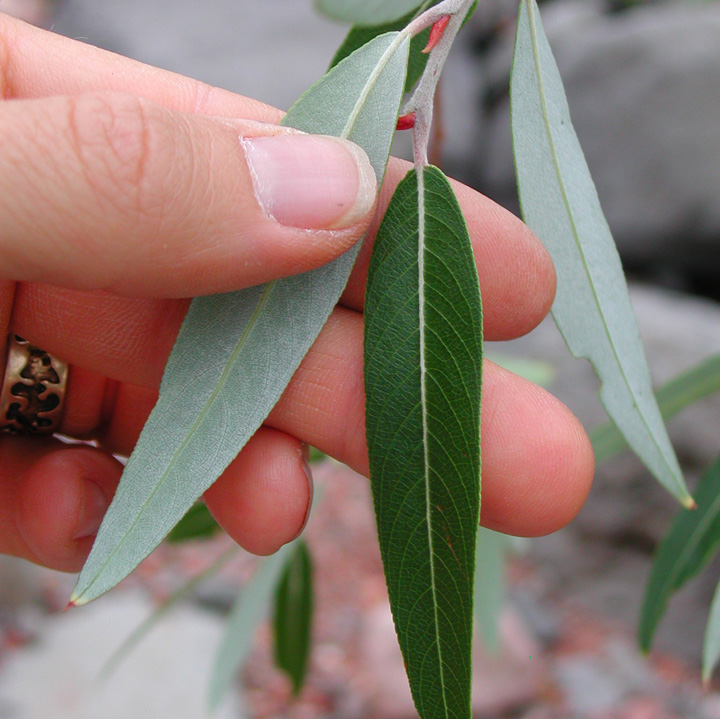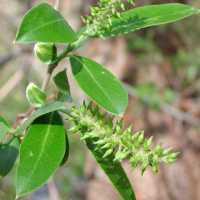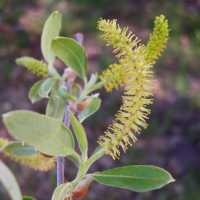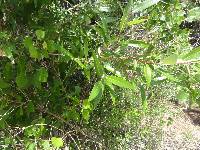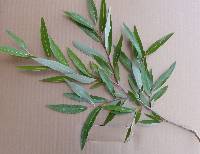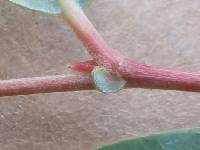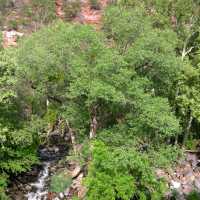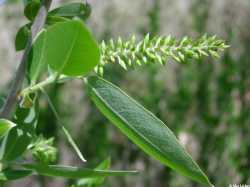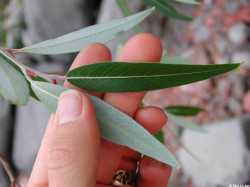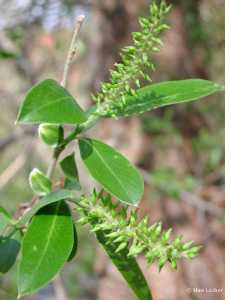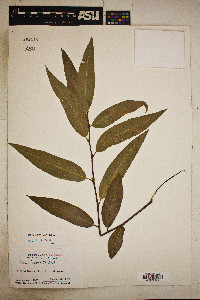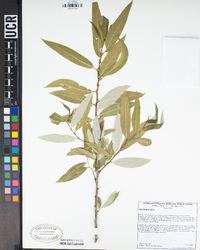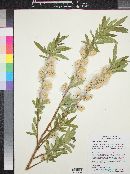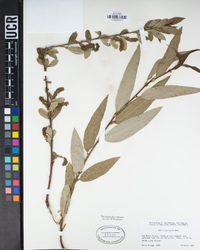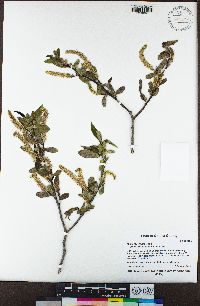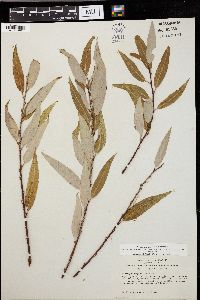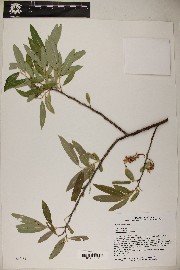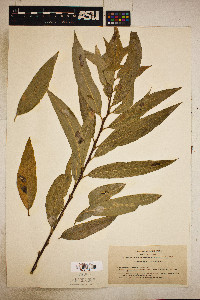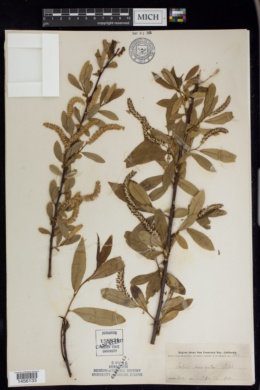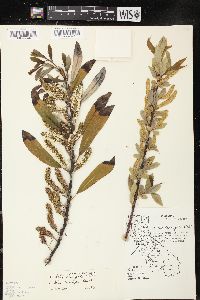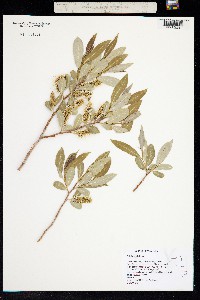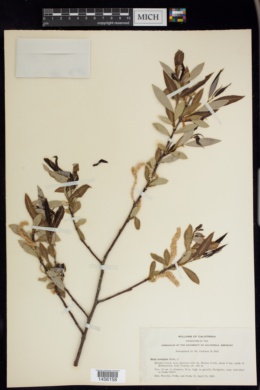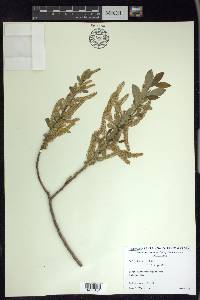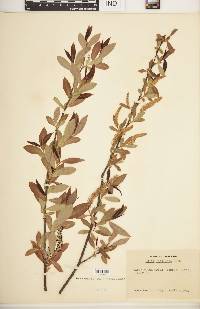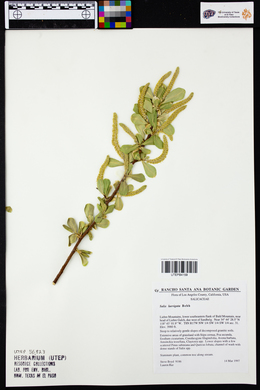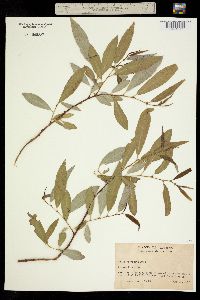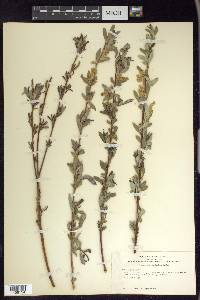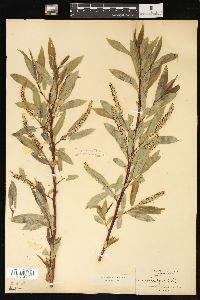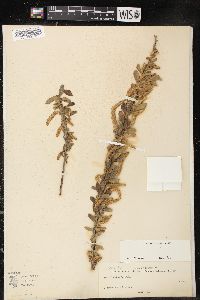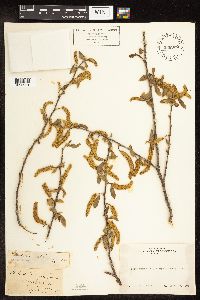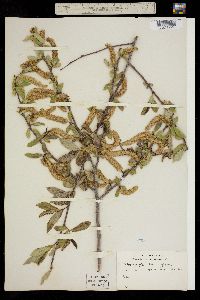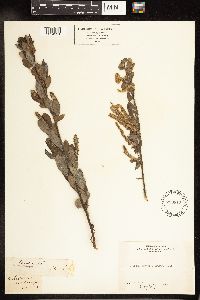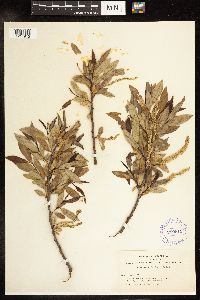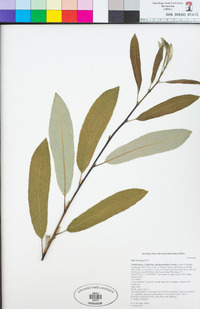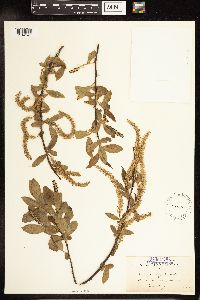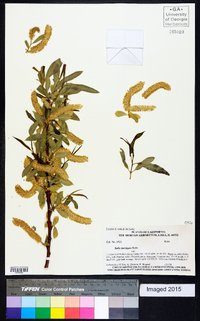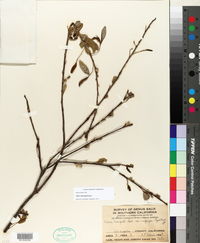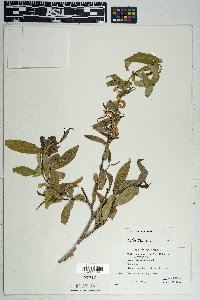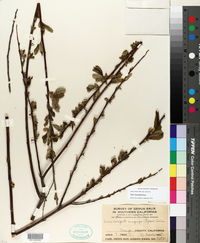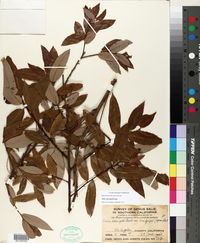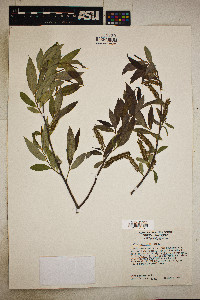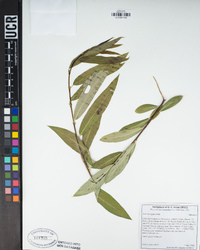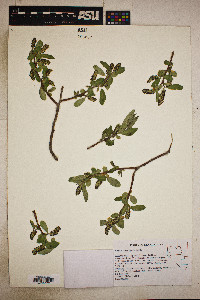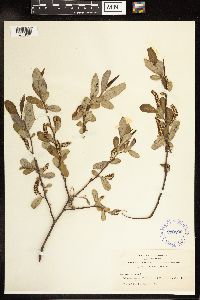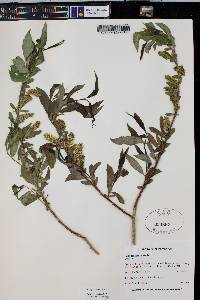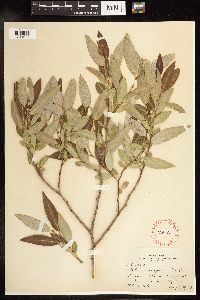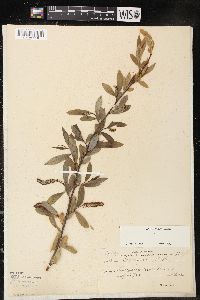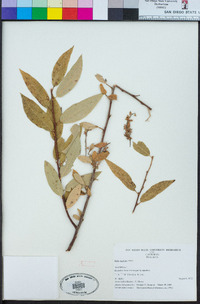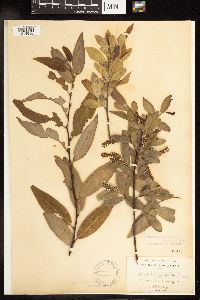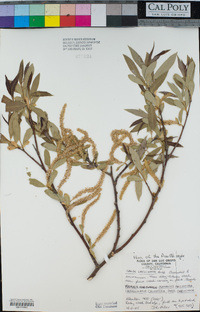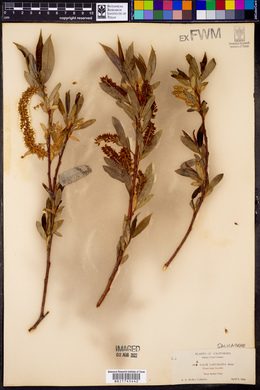
|
|
|
|
Family: Salicaceae
Polished Willow, more...red willow
[Salix bonplandiana var. laevigata (Bebb) Dorn, moreSalix congesta (Bebb ex Rothrock) J.T. Howell, Salix laevigata f. araquipa Jeps., Salix laevigata var. angustifolia Bebb ex Rothrock, Salix laevigata var. araquipa (Jepson) Ball, Salix laevigata var. congesta Bebb ex Rothrock, Salix laevigata var. laevigata] |
Trees, 2-15 m. Stems: branches flexible to highly brittle at base, gray-brown to yellow-brown, glabrous or villous; branchlets yellow-brown or red-brown, glabrous, densely villous, velvety, or pilose, nodes hairy. Leaves: stipules rudimentary grading into foliaceous or absent on early ones, usually foliaceous on late ones, apex acute, acuminate, rounded or convex; petiole (shallowly or deeply grooved adaxially, margins sometimes touching, sometimes with basilaminar glands, thickening), 3.5-18 mm, pubescent to glabrescent adaxially; largest medial blade lorate, narrowly oblong, narrowly elliptic, lanceolate, or obovate, 53-190 × 11-35 mm, 2.8-9 times as long as wide, base convex, subcordate, rounded, or cuneate, margins crenate, entire, or finely serrulate, apex acuminate, acute, or caudate, abaxial surface glabrous or pubescent, hairs spreading, white and/or ferruginous, adaxial highly or slightly glossy, glabrous or pubescent, midrib sometimes villous; proximal blade margins entire; juvenile blade glabrous or moderately densely long-silky to pilose abaxially, hairs white and/or ferruginous. Catkins: staminate 31-83 × 7-13 mm, flowering branchlet 2-26 mm; pistillate 28-79 × 6-11 mm, flowering branchlet 3-14 mm; floral bract 1.6-3.4 mm, apex rounded or acute, irregularly toothed or entire, abaxially sparsely to moderately densely hairy proximally or throughout, hairs wavy; pistillate bract deciduous after flowering. Staminate flowers: abaxial nectary 0.4-0.6 mm, adaxial nectary oblong, square, or ovate, 0.3-0.6 mm, nectaries distinct; stamens 3-7; filaments (sometimes basally connate), hairy on proximal 1/2 or basally; anthers 0.4-0.6 mm. Pistillate flowers: adaxial nectary square, 0.2-0.6 mm; stipe 1.4-2.8 mm; ovary pyriform, obturbinate, or ellipsoidal, beak slightly bulged below styles; ovules 12-24 per ovary; styles 0.1-0.2 mm; stigmas 0.2-0.23-0.28 mm. Capsules 3-5.5 mm. Flowering (Dec-)Feb or mid Apr-early Jun. Riparian forests along streams, seepage areas, springs, subalkaline or brackish lakeshores, canyons, ditches; 0-2200 m; Ariz., Calif., Nev., Oreg., Utah; Mexico (Baja California, Baja California Sur). Hybrids: Salix laevigata forms natural hybrids with S. gooddingii. Related Species: Salix humboldtiana Willdenow: Humboldt willow is not known to occur in the flora area. It is characterized by: trees, 4-25 m; branches highly brittle at base, bud-scale margins distinct and overlapping adaxially; stipules on late leaves rudimentary or foliaceous; largest medial leaf blade usually linear, abaxial surface not glaucous, adaxial dull; pistillate bract deciduous after flowering; stamens 3-7; capsules with distinct, often raised, white veins. It occurs throughout much of Mexico to central Chile. Salix humboldtiana is closely related to S. nigra in its generally narrow leaf blades, which are not glaucous abaxially. The two differ in the following characters: S. humboldtiana has leaf blades linear to sometimes narrowly oblong (10-28.6 times as long as wide), ovaries usually ovoid to ellipsoid, ovary walls often stomatiferous and with raised, white veins, and capsule valves relatively thick, slightly recurved. S. nigra has leaf blades usually narrowly lanceolate (6-13 times as long as wide), ovaries pyriform to obclavate, ovary walls neither stomatiferous nor notably veined, and capsule valves relatively thin and strongly recurved. Both species occur in Chihuahua, Mexico. The report by R. I. Lonard et al. (1991) that specimens identified as Salix nigra from the lower Rio Grande, Texas, resemble S. humboldtiana in having strongly veined capsules suggests that S. humboldtiana, or intergrades with that species, may occur in Texas. Attempts to locate a voucher specimen were unsuccessful; because strongly veined capsules are diagnostic, further field study is indicated. An earlier name, Salix chilensis Molina, has been applied to this species; it does not seem to pertain to this taxon (C. K. Schneider 1918).
Plant: tree; to 15 m tall; branches gray- or yellow-brown, villous becoming glabrous; branchlets yellow- or red-brown, villous, pilose, or velvety becoming glabrous, except at nodes; budscale margins free and overlapping Leaves: stipules rudimentary to leaflike; petioles villous becoming glabrous, 3.5-18 mm long, gland-dotted or not at base of blade; young leaves glabrous, pilose, or silky; mature blade ligulate to narrowly oblong, narrowly elliptic, lanceolate, or obovate, 53-190 mm long, 11-35 mm wide, 2.8-9 times as long as wide, the lower surface glaucous; upper surface shiny or highly glossy, glabrous or becoming so, the base rounded or subcordate to acute, the margins flat, crenate or very finely serrulate and appearing entire, with 7-12 teeth per cm, the apex acuminate to acute INFLORESCENCE: cylindrical to subspherical catkins; coetaneous; floral bracts tawny, 1.6-3.4 mm long, with wavy hairs, the apices rounded to acute; pistillate floral bracts deciduous after flowering Flowers: STAMINATE FLOWERS in densely to loosely flowered catkins, 18-90 mm long; flowering branchlets 2-32 mm long; stamens 3-7; filaments hairy at base only; nectaries 1 abaxial, 1 adaxial, broad to ovate, 0.3-0.6 mm long. PISTILLATE FLOWERS in loosely flowered catkins 22-70 mm long; flowering branchlets 3-30 mm long; ovaries glabrous; stigmas 0.2-0.28 mm long; styles 0.12-0.24 mm long; stipes 1.4-2.8 mm long; nectary square or half-cup-shaped, 0.2-0.5 mm long, shorter than stipe Fruit: lanceolate to ovate Misc: forests along rivers and creeks, seepage areas, springs, subalkaline or brackish lake shores, canyons, and ditches; 550-2200 m (1700-6900 ft); Feb-May REFERENCES: Argus, George W. 1995. SalicaceaePart 2. Salix. J. Ariz. - Nev. Acad. Sci. 29(1): 39 FNA 2010, Argus 1995 Common Name: red willow Duration: Perennial Nativity: Native Lifeform: Shrub Wetland Status: FACW General: Shrubs or trees to 15 m, bark reddish, especially on younger stems, older stems gray-brown to yellow-brown, can be smooth to pubescent. Leaves: Leaves bearing foliaceous stipules on mature leaves, on petioles 3.5-18 mm long, leaves narrowly oblong, elliptic, lanceolate, or obovate, 5-19 cm, approximately 9 times as long as wide, margins entire to finely toothed, smooth or pubescent. Flowers: Catkins yellow, bearing staminate and pistillate flowers, staminate flowers to 2-25 mm long, pistillate flowers 30-80 mm long, floral bracts 1.5-3.5 mm, staminate flowers bearing oblong, square, or ovate adaxial nectaries, pistillate flowers with square nectaries. Fruits: Capsules 3-5.5 mm. Ecology: Found in subakaline or brackish areas near streams, springs, and other wet zones, in riparian forests below 7,500 ft (2134 m); flowers February-June. Distribution: Ranges north to Oregon through California and Nevada and south into Baja California and south into northern Mexico Notes: Thought to hybridize with S. gooddingii, these species are difficult to identify where they co-occur. Ethnobotany: Unknown Etymology: Salix is the Latin name for willow, meaning -to leap or spring-, laevigata means smooth or slippery, lustrous or shining. Synonyms: Salix bonplandiana var. laevigata, Salix congesta, Salix laevigata var. angustifolia, Salix laevigata var. araquipa, Salix laevigata var. congesta Editor: LCrumbacher, 2011 |
|
|
|

